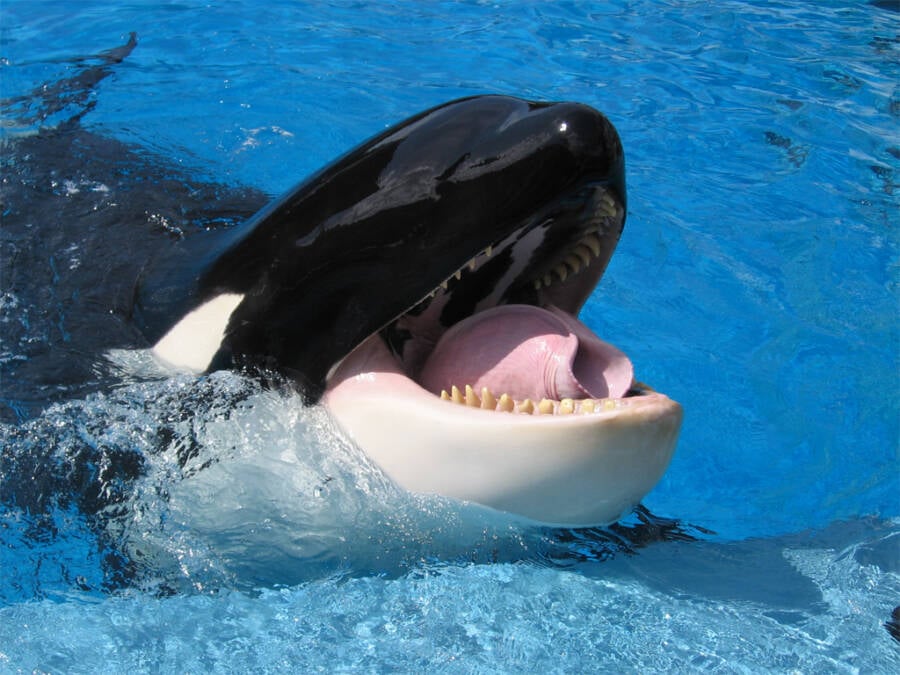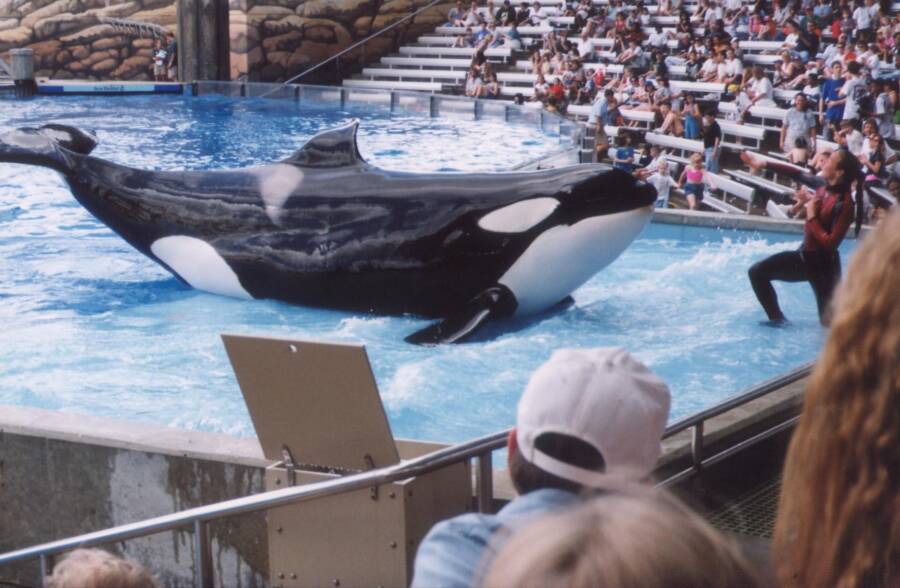In February 2010, Tilikum killed his trainer Dawn Brancheau during a performance at SeaWorld Orlando. The incident became the focus of the 2013 documentary Blackfish and sparked public outcry about the mistreatment of captive orcas.
Warning: This article contains graphic descriptions and/or images of violent, disturbing, or otherwise potentially distressing events.

Wikimedia CommonsTilikum was taken captive from the wild in 1983 and died at SeaWorld in 2017.
The 2013 documentary Blackfish presented a scathing portrayal of SeaWorld in the wake of the infamous death of one of its employees, Dawn Brancheau, in 2010. Brancheau had been killed by a nearly 6-ton orca named Tilikum — the very same orca she herself had trained and performed with in countless shows. But this was not the first time Tilikum had killed.
In fact, though few people realized it, Tilikum had been involved in not just one, but two previous deaths. In 1991, the orca killed another trainer, and in 1999, a trespasser.
Yet, it was difficult to blame Tilikum. He was an orca, an apex predator, subjected to a demanding schedule of training and performances and used in captive breeding efforts. If anyone was to blame, many argued, it was SeaWorld.
The company’s reputation declined sharply following Brancheau’s death and the release of Blackfish, a trend which continued in 2017 following Tilikum’s death, ultimately leading to a series of protests against SeaWorld’s treatment of marine animals and the end of the company’s orca breeding program.
This is Tilikum’s story.
Tilikum’s First Years In Captivity
In 1983, in the waters off the coast of Iceland, a two-year-old male orca whale was taken from his family and held in a concrete holding tank at Hafnarfjördur Marine Zoo near Reykjavík.
Stuck in cramped conditions for months, the young orca, given the name Tilikum, could barely swim in circles — especially as he grew in size, reaching 22.5 feet. Then, in 1984, he was shipped off to Sealand of the Pacific in Vancouver.
But Tilikum’s new home brought with it a host of new problems. As The Sun reported, Tilikum was housed with two older female orcas, Haida II and Nootka IV, in yet another cramped tank. It was only 26 feet wide, and the female orcas didn’t take to their younger tank mate kindly.
They regularly asserted their dominance over Tilikum, raking him with their teeth and physically abusing him. He developed stomach ulcers and was soon transferred to an isolated medical pool to heal.

Wikimedia CommonsTilikum spent more than 30 years in captivity, subjected to conditions that ex-trainers say drove him “psychotic.”
Tilikum’s problems were just beginning, however. And in 1991, the now 12,000-pound orca found himself embroiled in the first of several deadly incidents.
Tilikum’s Killing Streak Begins
In February 1991, a 21-year-old part-time trainer and marine biology student named Keltie Byrne slipped and fell into the pool housing Tilikum, Haida, and Nootka. With little hesitation, the orcas swarmed, pulling Byrne down under the water and dragging her through the pool.
According to the Whale Sanctuary Project, Byrne made several attempts to get away from the orcas. She reached the edge of the pool and attempted to climb out, but the orcas pulled her away and submerged her again.
Other staff members attempted to rescue Byrne by throwing her a life ring, but the orcas kept her away from it, treating her like a “plaything,” according to The Mirror. Over the course of 10 minutes, Byrne surfaced three times, trying to escape the orca tank. Unfortunately, she couldn’t, and drowned there in the pool.
Several hours passed before Sealand staff were able to recover her body.
“They never had a plaything in the pool that was so interactive,” Sealand’s head of animal training at the time, Steve Huxter, said of the attack. “They just got incredibly excited and stimulated.”

Wikimedia CommonsSince 1961, 174 orcas have died in captivity — not including 30 who were miscarried or stillborn.
The incident left a dark cloud over Sealand — one it could never cast aside. A mere 18 months after Byrne’s death, Sealand shuttered its doors, and Tilikum and his tank mates were sent off to SeaWorld.
This did little, however, to improve their situation, and seven years later, Tilikum was involved in a second death.
Tilikum’s Next Victim At SeaWorld
On July 6, 1999, SeaWorld Orlando trainers found an unwelcome surprise in Tilikum’s pool: the dead body of a 27-year-old man named Daniel Dukes, draped over the orca’s back. Dukes had been a visitor to SeaWorld the day before, and somehow dodged security and snuck into Tilikum’s pool in the middle of the night.
When trainers found him the next morning, Dukes was naked and covered in contusions and abrasions. His genitals had been bitten off. An autopsy determined that he had died by drowning.
SeaWorld additionally claimed that none of the cameras had caught the incident, and therefore, there was no way to determine what exactly had happened.
Still, SeaWorld continued its operations, and Tilikum made frequent appearances in the park’s various performances. A decade passed without incident, and one trainer in particular established a strong bond with Tilikum. Her name was Dawn Brancheau.
She would be Tilikum’s final victim.
The Death Of Dawn Brancheau
Dawn Brancheau started working as a trainer at SeaWorld Orlando in 1994, and by 2010, she had quite literally become the park’s poster girl and star trainer.
She was lauded as a dedicated professional by her colleagues, who noted her special connection with Tilikum, the orca who had been in captivity for nearly 30 years by this point. According to The Mirror, Brancheau’s colleagues said she and Tilikum had a strong sense of love and trust.
“He had a great relationship with her, and she had a great relationship with him,” said John Hargrove, one of SeaWorld’s senior trainers at the time. “I do believe that he loved her, and I know that she loved him.”

Wikimedia CommonsDawn Brancheau during a performance at SeaWorld.
But on February 24, 2010, the limits of the trust Brancheau and Tilikum had established were tragically put to the test.
During one of SeaWorld’s “Dine With Shamu” shows, visitors watched as Tilikum grabbed Brancheau and pulled her into the water. Some initial reports claimed he grabbed her by the ponytail, others that he grabbed her by the shoulder.
It wasn’t a quick death. As Tilikum dragged Brancheau across the pool, her left arm was torn from its socket, her spinal cord was severed, her ribs and jaw were broken, and her head was gruesomely scalped. SeaWorld employees later found Brancheau’s hair and skin at the bottom of the pool.
For 45 minutes following the attack, Tilikum refused to let go of his trainer’s body. Trainers were only able to recover Brancheau’s body after they lured Tilikum into a medical pool and calmed him down.
Brancheau’s death was brutal and tragic, and it spawned an onslaught of critical observations about SeaWorld. Many questioned the ethics of keeping orcas in captivity. Then, the 2013 documentary Blackfish delved further into the poor conditions captive orcas are subjected to — and how those conditions could have contributed to Brancheau’s death.
How Tilikum’s Life And Death Changed The Public Perception Of Captive Orcas
After Dawn Brancheau’s death, Tilikum was largely hidden away from the public eye. SeaWorld faced heavy scrutiny for their treatment of captive orcas and for using them in shows, and as more information came to light, the public learned the truth of just how terrible life was for captive orcas.
Jeffrey Ventre, a former SeaWorld trainer who joined the company in 1987, claimed in a 2018 interview with The Sun that the park’s captive killer whales often showed signs of extreme distress.
“There was a lot of self-mutilation,” he said. “The whales and dolphins were stressed and this caused stomach ulcers… They were also sometimes aggressive or hard to control, so they could be given Valium to calm their aggression.”
Since SeaWorld first opened in 1964, at least 49 captive orcas have died at its U.S. locations. Most of them died in their teens, whereas wild male orcas usually live into their 30s, and females often live to at least 50.
Tilikum lived to be 36.

Wikimedia CommonsDawn Brancheau in the middle of a performance with another orca, Katina.
Throughout his life, Tilikum had been used in captive breeding efforts and sired an estimated 21 calves. Eleven of them died before he did.
He spent the last few years of his life largely just lying in a pool until his death in January 2017.
How SeaWorld Changed After Tilikum’s Death
“Instead of the iconic, happy killer whale celebrated by SeaWorld and its fans for five decades,” Blackfish co-writer Tim Zimmerman wrote for National Geographic, “Tilikum demanded the world confront his reality, Shamu’s reality, which involved separation from family, confinement, boredom, chronic disease, aggression among marine park killer whales, and aggression against trainers.”
In the documentary, ex-SeaWorld trainer Samuel Berg expressed that he felt the treatment of captive orcas drove them to be “psychotic.”
“There has not been a single incident of killer whales harming humans in the wild. In captivity, it’s happened more than 70 times,” he said. “Someone said if you put a human in a bathtub for 25 years they’d be psychotic too, and it began to fall into place. I wasn’t training killer whales — I was messing with their minds.”
According to Whale and Dolphin Conservation, as of March 10, 2023, at least 54 orcas are held in captivity across the world. SeaWorld holds 18 of them.
Since 1961, a total of 166 orcas have been taken into captivity from the wild. 131 have since died.
SeaWorld put an end to its breeding program in 2016, and the events following Brancheau’s death turned away visitors in droves. Meanwhile, SeaWorld continues to feature orcas in shows across its three U.S. parks. The company says these presentations will phase out with the last of its current captive orca population.
While Tilikum’s story is tragic, and made even more tragic by the deaths of the people he killed, there was some good that came of it: It brought the poor treatment of captive orcas to light.
After learning about the sad story of Tilikum, SeaWorld’s most infamous killer whale, read about the release of Lolita, the second-oldest orca in captivity. Then, read the story of Tahlequah, the orca who carried her dead calf for 17 days.





